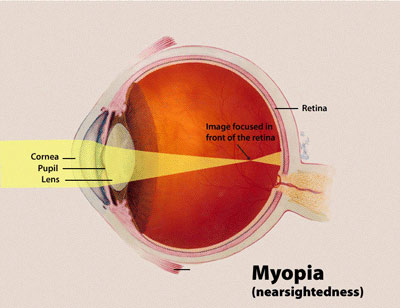
Myopia Treatment Choices
According to the National Eye Institute (NEI), myopia is a “common type of refractive error where close things appear clearly, but distant objects look fuzzy” and myopia treatment choices range from common glasses or contacts to myopia surgery.
Myopia Treatment Choices
According to the National Eye Institute (NEI), myopia is a “common type of refractive error where close things appear clearly, but distant objects look fuzzy” and myopia treatment choices range from common glasses or contacts to myopia surgery.
What’s myopia?
Commonly called nearsightedness, myopia basically suggests the eyeball is incapable of focusing images correctly on the retina, resulting in what you’re seeing to be focused in the front of the retina.
It might also be brought on by an excessively thick lens, or any combo of issues regarding the lens, eyeball length, and corneal curvature.
Whatever the case, the truth is that your eyesight is going to be negatively affected, making focusing correctly on items at a distance very difficult.
NEI statistics reveal that at 2004, the proportion of the US population with myopia has increased to 41.6 percent (a rise of 16.6 percent from 1972) which was over ten decades ago so the proportion is probably much higher now.
The sheer quantity of people who have myopia, and its incidence as a predisposing factor for other eye associated problems like glaucoma, retinal detachment, and myopic retinopathy, have a lot of eye specialists saying that myopia is a substantial public health issue that’s getting worse.
Degenerative myopia
Oftentimes, nearsightedness is a hassle since it poses little if any threat to the health of the eye. There are often more health threatening related issues like retinal detachment, myopic retinopathy, and glaucoma that myopia is often a predisposing condition for. In all these instances, treatment should be performed by an ophthalmologist.
Degenerative myopia is an uncommon condition that’s also called malignant myopia or pathological myopia. This disorder is an accelerated form of myopia which frequently occurs in children, is generally genetic (hereditary and also contributes to a rapid loss of vision and legal blindness.
Fixing Myopia
The principal treatment options for myopia comprise of contacts and eyeglasses. While these myopia treatment options are exceptionally capable of correcting the refractive error which leads to the myopic focus, these treatment choices don’t slow the eyeball from growing or axial elongation.
Laser refractive surgery is also a possible treatment for myopia. LASIK physically alters corneal tissue to correctly permit the light to concentrate in the appropriate position, and may reduce or eliminate the need to wear eyeglasses or contacts.
The Myopia Experts at Beach Eye
If you have problems with squinting, eye strain, headaches, tired eyes when driving a car or performing everyday tasks, or possess glasses (or contact lenses) for nearsightedness and still encounter these or other associated symptoms, please schedule an eye exam with one of our doctors at Beach Eye Medical to evaluate your specific situation, correctly diagnosis the myopia or other possible, severe ocular disorders, and explore the alternatives.
You can rest assured that your myopia will be more manageable and learn whether you’re a candidate to achieve clearer vision with LASIK, and make certain you don’t have any serious ocular disorders in which myopia may be a predisposing factor for.




